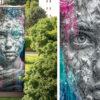
With apologies to W.H. Auden[1]
By Joseph Mangina
Everything within creation
Speaks of Jesus’ Incarnation.
Likewise too, his saving Passion
Is shown forth in all that’s fashioned.
Advertisement
The Word God spoke before all ages
Can be traced in Scripture’s pages.
The Bible tells one vast narration
from Genesis to Revelation.
Just don’t call it “salvation history,”
a recipe for taming mystery.[2]
But concrete images that foment
Our faithful living in the Moment.
The gospel-tale of Jesus Lord
is figured in the ancient Law.
And both together speak our world,[3]
As time’s scroll is unsealed, unfurled,
To form the fabric of our days:
We read the Word, and end in praise.
The church’s doctors knew this art,
from Augustine and Basil to Karl Barth.
With literal sense[4] did they begin
Then looked for hidden meaning within.
In figure, type, and allegory,
They sought for echoes of Jesus’ story.
God’s speech: not facts meant to inform us,
But utterance that would transform us.
In modern times, this art declined
in favor of the historical mind.[5]
The Bible, said Jowett, is worth a look.
But read it “like any other book.”[6]
No mysteries or figures gleaning:
The author’s intent just is the meaning.
A claim that even fails the test
Of poetry and novels best.
For when Jane Austen Emma wrought,
She surely said more than she thought.
And Dostoevsky’s Brothers K
Is more than any man can say.
Now God, who knows all things, is master
Of both the spirit and the letter.
Our human words of things do tell,
But God’s words are the things themselves —
The world of creatures, persons, stories,
An alphabet that leads to glory.
Thus every line of Scripture’s pregnant
With multiple senses, meanings fragrant.
As Thomas[7] in the Summa taught —
How Christ, who our redemption bought,
Is figured in the holy pages
Of Israel’s prophets, singers, sages.
The same is true, if more dramatic,
In Barth’s great Kirchliche Dogmatik.
Especially the print that’s tiny,
Excursuses that drip of honey,
A meditation on the Word,
The mind’s own service to the LORD.
But what’s the method? Where the fences?
If truly there are many senses,
Can texts mean anything we choose?
— so biblical scholars challenge those
Who tout patristic exegesis
And other readings of that species.
But rules aren’t lacking ’neath the sun.
The church’s rule of faith for one:
One God, Creator of earth and heaven,
One Lord, in whom salvation’s given,
Canon prophetic and apostolic —
So Irenaeus, anti-Gnostic.
Tradition, subordinate to the Word,
Which to ignore would be absurd.
Lastly, reason — not just smarts,
But reading with wit and grace and art,
Always tempered with humility,
And awareness of human fallibility.
History’s a helpful tool,
But use it lightly — not a rule,
Or iron law that all explains,
For that’s historicism’s bane,
The view that truth is what time gauges,
With God tucked in around the edges.
But God’s not limited by history:
The world of time’s enclosed in mystery.[8]
Reading Scripture is no buffer
To a world where people suffer.
It rather shows our mortal flesh
Held fast by God’s own tenderness.
We needn’t to the past take flight:
the Fathers were not always right,
Nor were Reformers always true
To Truth that they proclaimed, and knew.
By faith alone we’re justified,
An antidote to every pride
Of mind, and eye, and lust for treasure
That would trim God to suit our measure.
Even the keenest exegete
Must bow in worship, as is meet,
To Jesus Christ, of all things Lord,
Present as Bread, and Wine, and Word.[9]
[1] See Auden, “Academic Graffiti,” Collected Poems, 1976. That I am no Auden will be painfully obvious. But perhaps this poem may provide a useful as well as amusing orientation to the world of figural exegesis of Scripture.
[2] A bit of an exaggeration. Heilsgeschichte has its uses. The caution here is against over-extension of the concept into a comprehensive framework for reading the Bible.
[3] A Christian version of the Jewish claim that “everything is in the Torah.” See Mishnah Pirkei Avot, 5:22: “Turn it over and over, for everything is in it.”
[4] A surprisingly slippery notion. For Thomas and the medievals, the sensus literalis basically meant the plain sense, the obvious sense of the words on the page — which could include such things as metaphor, or even Old Testament references to Christ. The term literal in modern use has a far narrower connotation.
[5] The story is told in Hans Frei, The Eclipse of Biblical Narrative, 1974.
[6] Benjamin Jowett, Regius Professor of Greek at Oxford, famously argued that the Bible should be read “like any other book,” strictly with an eye to the human author’s intention. Jowett, “On the Interpretation of Scripture,” 1859.
[7] Thomas Aquinas, Summa Theologiae, 1a1ae, q. 1, aa. 9-10.
[8] On the question of Scripture’s relation to time, see Ephraim Radner, Time and the Word: Figural Reading of Christian Scripture (2016). This book is an indispensable guide to the larger landscape of figuralism, especially as it pertains to preaching.
[9] Thanks to the Rev. Fleming Rutledge, a master figural preacher, whose question over a post-Christmas brunch prompted these musings.
This post was originally published on this site be sure to check out more of their content.









